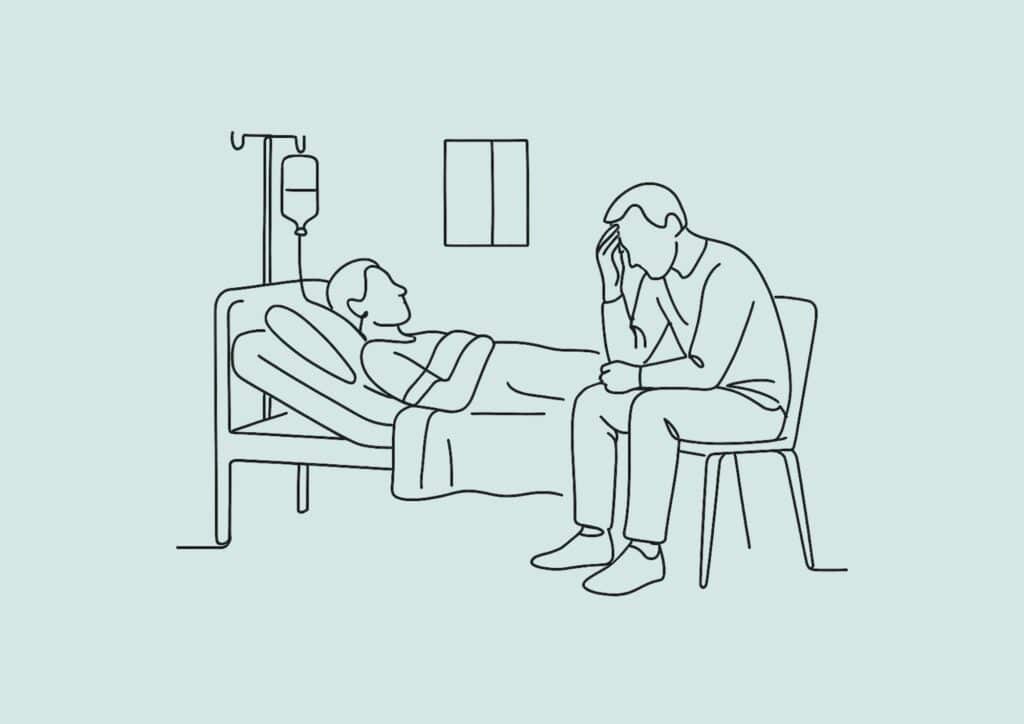For families facing difficult decisions about a loved one’s hospital care, understanding when and how to transition to hospice care can provide clarity during emotionally challenging times. Whether you’re a family member advocating for your loved one or a healthcare provider facilitating these important transitions, this guide offers practical information about moving from hospital-based curative care to comfort-focused hospice services.
Hospital-to-hospice transitions represent more than a change in treatment location. They reflect a fundamental shift from pursuing aggressive medical interventions to prioritizing comfort, dignity, and quality time together. Understanding this transition process can help families make informed decisions and work effectively with their healthcare teams.
Recognizing When Hospital-to-Hospice Transition May Be Appropriate
Families often struggle to know when it’s time to consider hospice care for their hospitalized loved one. Understanding common indicators can help families have meaningful conversations with their healthcare team about the most appropriate care approach.
Signs That May Indicate Hospice Appropriateness
Frequent hospital readmissions often signal that a loved one’s condition is progressing despite medical interventions. When someone experiences multiple hospitalizations for the same condition or related complications over a short period, it may indicate that aggressive treatments are no longer providing significant benefit and that comfort care could be more appropriate.
A declining ability to recover becomes evident when each hospitalization leaves your loved one weaker or less functional than before. If previous treatments that once helped are no longer effective, or if recovery periods are becoming longer and more difficult, these may be signs to discuss hospice care with the medical team.
Decreased quality of life due to medical interventions can indicate that the burden of treatment is outweighing the benefits. When treatments cause significant side effects, discomfort, or prevent meaningful interaction with family, it may be time to consider focusing on comfort rather than cure.
Expressions of being “ready” or “tired” from patients themselves often provide important insight into their own understanding of their condition and their wishes for care. Healthcare providers and families should listen carefully when patients express these feelings.
Questions Families Can Ask Healthcare Providers
Understanding your loved one’s condition and prognosis requires asking direct questions that healthcare providers can help answer:
- “What would happen if we focused on comfort care instead of continued aggressive treatment?”
- “How does my loved one’s current condition align with hospice eligibility criteria?”
- “What are the realistic outcomes if we continue current medical interventions?”
- “Would my loved one benefit from a palliative care consultation to explore all options?”
Medicare hospice benefits provide comprehensive coverage for hospice services, removing financial barriers that might prevent families from considering this option. If you have questions about eligibility, the National Hospice and Palliative Care Organization offers detailed hospice eligibility guidelines.
Understanding Family Emotions and Decision-Making
Feeling overwhelmed by medical decisions is completely normal when facing the possibility of transitioning to hospice care. Families often experience conflicting emotions—wanting to continue fighting the illness while also wanting to prevent unnecessary suffering.
Concerns about “giving up” frequently arise when families first hear about hospice care. It’s important to understand that choosing hospice care doesn’t mean giving up hope—it means redirecting hope toward comfort, peace, and meaningful time together rather than focusing solely on cure.
Cultural and religious considerations play important roles in end-of-life decision-making. Families should feel comfortable discussing their beliefs and values with healthcare teams to ensure that care decisions align with their personal and spiritual needs.
Time to process information is essential, as these decisions often cannot and should not be rushed. Healthcare providers should allow families adequate time to discuss options privately and ask questions before making final decisions about hospice care.
What Families Should Expect During the Transition Process
Understanding what happens during a hospital-to-hospice transition can help families feel more prepared and confident about the process.
Medical Assessment and Planning
Comprehensive condition review involves healthcare providers evaluating your loved one’s current symptoms, pain levels, and overall condition to determine if hospice care is appropriate. This assessment helps ensure that hospice services can effectively meet your loved one’s comfort needs.
Medication evaluation focuses on transitioning from curative medications to comfort-focused treatments. The healthcare team will review current medications with hospice providers to ensure effective pain and symptom management continues seamlessly.
Care goals discussion helps clarify what’s most important to your loved one and family during this time. This conversation ensures that the hospice care plan aligns with personal values and priorities for the remaining time together.
Family Support and Education
Understanding hospice services includes learning about the comprehensive support available through hospice care—not just medical care, but also emotional, spiritual, and practical support for the entire family.
Caregiver preparation involves teaching family members:
- Basic comfort care techniques
- Medication management
- When to contact the hospice team
This education helps families feel confident about providing care at home.
Emotional support resources become available through hospice social workers and chaplains who can help families process the emotions involved in transitioning to end-of-life care.
Having Important Conversations with Healthcare Teams
Transitioning to hospice care often requires families to participate in difficult but important conversations with healthcare providers about prognosis, treatment options, and care goals.
Discussing Prognosis and Treatment Options
Asking for honest information about your loved one’s condition helps families make informed decisions. Healthcare providers should provide clear, compassionate explanations about disease progression and realistic expectations for different treatment approaches.
Understanding treatment burdens and benefits involves discussing whether continued aggressive interventions are likely to improve quality of life or may cause additional suffering. These conversations should focus on what matters most to your loved one and family.
Redefining hope often becomes necessary when curative treatments are no longer effective. Hope can shift from hoping for cure to hoping for comfort, peace, meaningful conversations, and time together free from pain and distress.
Family Meeting Best Practices
Preparing for family meetings includes writing down questions in advance, identifying who should be present for important discussions, and considering what information you need to make decisions about care.
Advocating effectively for your loved one means asking questions, expressing concerns, and ensuring that care decisions align with their known wishes and values. Organizations like the Patient Advocate Foundation can provide additional support for families navigating these decisions.
Taking time to decide is important—families should not feel pressured to make immediate decisions about hospice care. Healthcare providers should allow adequate time for families to process information and discuss options together.
Coordination with Hospice Teams
Effective hospital-to-hospice transitions require close collaboration between hospital staff and hospice providers to ensure continuity of care and prevent gaps in service.
Referral Process and Documentation
Timely referral initiation helps ensure that hospice evaluations can occur while patients are still hospitalized, allowing for comprehensive planning and smoother transitions. Early referrals also provide families with more time to understand and accept hospice services.
Complete medical records transfer should include recent history, current medications, advance directives, and family contact information. The Centers for Medicare & Medicaid Services (CMS) requires specific documentation for hospice eligibility determination.
Insurance verification and pre-authorization processes should be initiated early to prevent delays in hospice admission and ensure seamless financial transitions.
Care Plan Coordination
Symptom management transition requires careful coordination to maintain comfort during the transfer from hospital to hospice care. This includes ensuring adequate pain medication supply and clear instructions for symptom management.
Equipment and supply planning helps ensure that necessary medical equipment, medications, and supplies are available at the discharge location before the patient arrives home.
Emergency planning includes clear instructions for families about when to contact hospice services versus when emergency medical services might be appropriate, preventing confusion during crisis situations.
Preparing for Discharge to Hospice Care
When the decision is made to transition to hospice care, several important steps help ensure a smooth transition from hospital to home or hospice facility.
What Families Should Expect on Discharge Day
Pain and symptom control should be optimized before leaving the hospital to ensure your loved one is comfortable during the transition. The healthcare team should coordinate with hospice providers to prevent any gaps in medication or comfort measures.
Family education completion ensures that family members understand basic care techniques, medication schedules, and emergency procedures before taking on caregiving responsibilities at home.
Equipment and supply coordination involves making sure that necessary medical equipment, medications, and comfort items are available at the discharge location before your loved one arrives home.
Emergency contact information should be clearly provided, including 24/7 hospice contact numbers and guidance about when to call the hospice team versus when emergency services might be appropriate.
Transportation and Home Preparation
Safe transportation arrangements should consider your loved one’s comfort and medical needs during travel, ensuring that the journey from hospital to home is as comfortable as possible.
Home environment preparation may involve setting up a hospital bed, ensuring accessibility for medical equipment, and creating a peaceful, comfortable space for care.
Hospice team coordination typically includes having a hospice nurse visit shortly after discharge to assess your loved one’s condition and provide the immediate support to the family.
Common Concerns and How to Address Them
Families considering hospital-to-hospice transitions often have legitimate worries and questions that can be addressed through education and support.
“Are We Giving Up Too Soon?”
This is one of the most common concerns families express. It’s important to understand that choosing hospice care isn’t about giving up—it’s about choosing comfort, dignity, and quality time together when aggressive treatments are no longer providing benefit.
“What if We’re Not Ready?”
This reflects the difficulty of transitioning from hoping for cure to accepting end-of-life care. Families should know that they can take time to process this decision and that hospice teams are skilled at supporting families through these emotional transitions.
“Will There Be Enough Support at Home?”
This concern can be addressed by understanding that hospice care includes 24/7 on-call support, regular nursing visits, and comprehensive family education to ensure confidence in providing care.
Financial Concerns About Hospice Costs
These worries are often resolved by understanding that Medicare, Medicaid, and most private insurance plans provide comprehensive coverage for hospice services.
What to Do if Concerns Arise
Seeking second opinions is always appropriate when making important healthcare decisions. Families should feel comfortable requesting additional consultations or seeking input from palliative care specialists.
Requesting family meetings can help address concerns and ensure that all family members understand the situation and available options.
Contacting patient advocacy services available at most hospitals can provide additional support for families navigating complex healthcare decisions.
Quality Indicators for Successful Transitions
Measuring the success of hospital-to-hospice transitions helps healthcare organizations improve their processes and outcomes.
Patient and Family Satisfaction Metrics
Transition experience ratings provide insight into how well the discharge process met patient and family needs and expectations.
Hospice care satisfaction indicates whether the transition resulted in appropriate care that aligned with patient and family goals.
Family preparedness assessments measure how well the discharge process prepared families for the realities of home hospice care.
Clinical Outcome Measures
Readmission rates to acute care facilities can indicate the success of transition planning and hospice care coordination.
Pain and symptom control during the transition period reflects the effectiveness of medication management and care coordination.
Length of hospice stay may indicate the appropriateness of referral timing and the success of early intervention efforts.
State-Specific Resources
Families have access to specific resources and support organizations that can provide additional guidance during hospital-to-hospice transitions.
Professional Organizations and Support
Ohio Home Care & Hospice Association provides resources for families and professionals in Ohio, including educational materials and referral assistance.
Indiana Hospice & Palliative Care Organization offers information about hospice services and support for families throughout Indiana.
Pennsylvania Hospice Network serves as a resource for families and healthcare providers seeking hospice care information in Pennsylvania.
Regulatory and Quality Assurance
State health departments provide oversight of hospice organizations and can assist families with questions about quality standards and compliance.
Medicare and Medicaid services are consistently available nationwide, ensuring that eligible families have access to comprehensive hospice coverage.
Frequently Asked Questions
Can hospice care be provided in a nursing home?
Yes, hospice care can be provided wherever the patient calls home, including nursing homes, assisted living facilities, and private residences.
What services are included in hospice care?
Hospice care includes medical care, pain management, emotional and spiritual support, medical equipment and supplies, and bereavement support for families.
How long can someone receive hospice care?
Hospice care is available as long as the patient meets eligibility criteria, which is typically a six-month life expectancy if the disease follows its normal course.
Conclusion
Transitioning from hospital care to hospice care represents a significant decision that affects the entire family. By understanding the process, asking the right questions, and working closely with healthcare teams, families can ensure their loved ones receive compassionate, dignified care that aligns with their values and wishes.
Remember that choosing hospice care is not about giving up hope—it’s about redirecting hope toward comfort, meaningful time together, and quality of life during a difficult journey.
At ViaQuest Hospice, we understand the complexity of hospital-to-hospice transitions and work closely with healthcare partners to ensure seamless care coordination. Our experienced team provides support throughout the referral process, from initial consultation to post-discharge follow-up, helping ensure that patients and families receive the comprehensive support they need during this critical transition.
Ready to learn more about hospital-to-hospice transitions and hospice care options?
[Download Free Hospice Care Guide]
Our comprehensive Hospice Care Guide includes detailed information about hospice services, eligibility criteria, and what families can expect during the transition process. This resource helps both families and healthcare providers understand when hospice care may be appropriate and how to navigate these important decisions.For consultation about specific situations or to discuss hospice care options in Ohio, Indiana, or Pennsylvania, call ViaQuest Hospice at (855) 289-1722. Our clinical team is available 24/7 to provide guidance on hospital-to-hospice transitions and support families and healthcare providers through these important care decisions.





